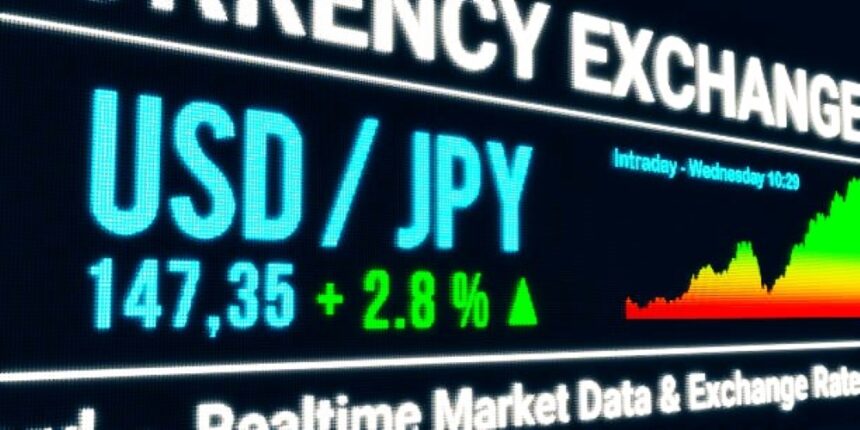Japanese Yen Slumps Near Monthly Low as BoJ Caution and Trade Frictions Weigh Heavily.
The Japanese Yen (JPY) extended its bearish trajectory on Wednesday, languishing near a monthly low against the US Dollar (USD) during the Asian session. Investors’ waning expectations for another Bank of Japan (BoJ) rate hike in 2025, compounded by escalating trade frictions between the US and Japan, have been key drivers of the Yen’s recent weakness.
The lack of meaningful follow-through in USD buying ahead of the Federal Open Market Committee (FOMC) interest rate decision did little to reverse the USD/JPY pair’s upward movement, with the pair maintaining upward momentum for the fourth straight day.
The BoJ’s recent meeting concluded with a decision to leave interest rates unchanged at 0.5%, as widely expected, while reiterating a cautious approach toward reducing its government bond purchases. This cautious outlook was perceived by markets as dovish and sparked a repricing of BoJ rate expectations further into the future — now forecasted for the first quarter of 2026.
Monetary Policy Divergence: BoJ Dovish, Fed Uncertain
This growing divergence in policy outlook between the BoJ and the US Federal Reserve is at the heart of the Yen’s struggles. While the BoJ signals no urgency to tighten further, the Fed — despite signs of a slowing economy — continues to keep rate cuts on hold until it sees more convincing disinflation trends.
With investors now eyeing the Fed’s policy statement for forward guidance, any reaffirmation of a September rate cut could limit the USD’s upside. However, geopolitical tension in the Middle East and ongoing trade tensions between the US and Japan have rekindled safe-haven demand for the greenback, which remains a key reason behind the USD’s resilience.
BoJ Slows Bond Reduction Plans, Delays Rate Hike Outlook
In its June policy announcement, the BoJ not only kept rates steady but also signaled a slower pace of tapering its bond purchases, set to begin April next year. The central bank emphasized that Japan’s economic growth is likely to moderate in the coming quarters, citing persistent uncertainties in global demand and domestic consumption.
The cautious policy message reinforced the view that the central bank is unlikely to proceed with additional rate hikes in the short term. A Reuters poll conducted after the decision revealed that a slight majority of economists now expect the next 25-basis-point BoJ hike only in early 2026 — a notable delay from previous market expectations of another 2025 hike.
This re-pricing in policy trajectory has significantly undermined demand for the JPY, as investors seeking yield shift toward currencies like the USD, especially in the absence of concrete tightening plans from Tokyo.
Trade Tensions Add Pressure as G7 Talks Disappoint
Trade relations between the US and Japan added further downward pressure on the Yen. Despite high-level discussions at the G7 summit, no major progress was reported on tariff issues. Japanese Prime Minister Shigeru Ishiba noted that while he and US President Donald Trump agreed to continue dialogue through their respective trade ministers, both sides still have unresolved concerns.
This lack of a breakthrough, especially with a July 9 deadline looming for reciprocal US tariffs, has heightened investor anxiety about a potential economic fallout in Japan. Protectionist measures could weigh on Japan’s export-driven economy — further complicating the BoJ’s monetary policy dilemma.
Without a concrete trade deal or a rollback in tariffs, the Japanese economy could be exposed to additional downside risks, making a strong case for prolonged accommodative policy and, by extension, Yen weakness.
Domestic Data Disappoints: Machinery Orders Collapse
Adding to JPY’s woes, recent economic data out of Japan has been underwhelming. Core machinery orders, a leading indicator of capital spending, slumped 9.1% in April — a sharp reversal from the 13% surge recorded in March and the worst performance since April 2020.
The weak reading underscores the fragile state of corporate confidence and investment in Japan, further justifying the BoJ’s cautious stance. A weakening economic outlook not only diminishes the chances of policy normalization but also highlights Japan’s vulnerability to external shocks, especially trade-related ones.
The monthly Reuters Tankan survey echoed this sentiment, showing a decline in business confidence among Japanese manufacturers in June. Respondents cited concerns about weakening global demand and uncertainty surrounding future trade relations with key partners, including the US and China.
US Data Adds Mixed Signals but Supports Fed Cut Narrative
In contrast, US economic indicators released Tuesday were also weaker than expected but had a muted effect on the Dollar. The US Census Bureau reported a 0.9% decline in retail sales for May, exceeding the expected 0.7% contraction. Simultaneously, industrial production dropped by 0.2%, also missing forecasts.
These numbers point to a cooling US economy and add fuel to market bets that the Federal Reserve may begin cutting interest rates in September. However, with inflation still sticky and labor market conditions relatively robust, the Fed is likely to tread carefully.
Investors are now keenly awaiting the FOMC’s decision and updated economic projections due later Wednesday. A dovish pivot or acknowledgment of economic slowing could halt the USD/JPY uptrend, while a neutral or hawkish tone could see the pair push toward new highs for the month.
Geopolitical Tensions Boost USD as a Safe Haven
Interestingly, while soft US data would traditionally weigh on the Dollar, geopolitical risks have offset the downward pressure. Heightened conflict risk in the Middle East, especially involving Israel and Iran, has led to increased demand for safe-haven assets — including the US Dollar.
This influx of risk-averse capital into the USD has limited the downside stemming from weak data and allowed the greenback to maintain its gains against lower-yielding currencies such as the Yen.
Safe-haven buying has been particularly evident in government bonds, with US Treasury yields falling modestly amid rising demand. The inverse relationship between yields and bond prices further solidifies the view that investors are bracing for elevated geopolitical risk in the near term.
Market Outlook: Focus on FOMC and US-Japan Tariff Timeline
Looking ahead, the immediate focus shifts to the FOMC policy announcement and the accompanying Summary of Economic Projections (SEP). Traders will dissect the dot plot to understand whether Fed officials are aligned with market pricing for a September rate cut.
Any hawkish surprises could reinforce the USD’s strength and push USD/JPY beyond current monthly highs. On the flip side, dovish forward guidance or acknowledgment of mounting economic risks could trigger a corrective move lower in the pair.
Beyond the Fed, attention will remain on the evolving US-Japan trade dynamic. The July 9 tariff deadline is fast approaching, and any hardening of trade rhetoric or imposition of duties could act as a fresh headwind for Japanese exports and the broader economy likely prompting further JPY depreciation.
Meanwhile, from a technical perspective, Japanese yen appears to be testing resistance near recent swing highs. Without clear follow-through buying or new catalysts, the pair may struggle to break out meaningfully, especially if traders opt for caution ahead of the FOMC and key geopolitical updates.
Conclusion: Japanese Yen Faces Multiple Headwinds in Fragile Environment
The Japanese Yen finds itself in a precarious position, undermined by a confluence of dovish monetary policy signals, disappointing domestic data, and escalating trade tensions with the United States. As BoJ rate hike expectations recede into 2026, and political leaders struggle to forge trade consensus, the JPY may continue to underperform its peers — especially against the US Dollar.
However, the trajectory of the USDJPY pair remains contingent on forthcoming developments, particularly the Fed’s guidance on interest rates and any tangible progress or deterioration in US-Japan trade negotiations.
With risk sentiment being further shaped by Middle East tensions, traders should brace for heightened volatility in the coming sessions.
[faq-schema id=”39941″]









